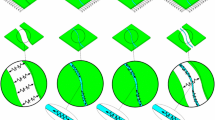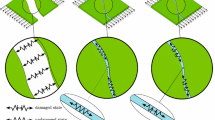Abstract
A model introducing cohesive zones around material interfaces to simulate interfacial damage in microheterogeneous materials is developed. The material behavior within the cohesive zones is unknown a-priori, and is weakened, or "relaxed", on the continuum level from an initially undamaged state, by a reduction of the spatially variable elasticity tensor's eigenvalues. This reduction is initiated if constraints placed on the microstress fields, for example critical levels of pressure or deviatoric stresses, are violated. Outside of the cohesive zones the material is unaltered. Numerical computations are performed, employing the finite element method, to illustrate the approach in three dimensional applications.
Similar content being viewed by others
REFERENCES
Metals Handbook (1978).Failure Analysis and PreventionThe American Society for Metals.Volume 9, 88.
Needleman, A. (1987).A continuum model for void nucleation by inclusion debonding J.Appl Mech. 54, 525-531.
Needleman, A. (1992) Micromechanical modeling of interfacial decohesion Ultramicroscopy 40, 203-214.
Ortiz, M. and Pandolfi. A. (1999). Finite deformation irreversible cohesive elements for three-dimensional crack-propagation analysis. The International Journal of Numerical Methods in Engineering.44) 1267-1282.
Wriggers, P. (1995) Finite element algorithms for contact problems. Archives of Computational Methods in Engineering. 2, 4, 1-49.
Zohdi T. I. and Wriggers, P. (under review). Some aspects of the computational testing of the mechanical properties of microheterogeneous material samples.
Zohdi, T. 1. and Wriggers P. (under review). A model for simulating the dete-rioration of structural-scale material responses of microheterogeneous solids.
Author information
Authors and Affiliations
Rights and permissions
About this article
Cite this article
Zohdi, T.I., Wriggers, P. A Computational Model for Interfacial Damage Through Microstructural Cohesive Zone Relaxation. International Journal of Fracture 101, 9–14 (2000). https://doi.org/10.1023/A:1007637128498
Issue Date:
DOI: https://doi.org/10.1023/A:1007637128498




